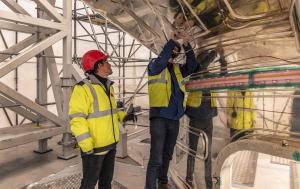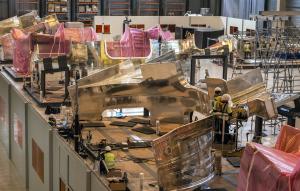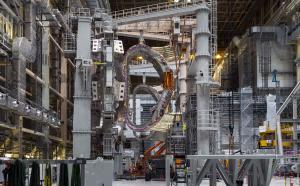With contracts in place, the repair campaign has begun
Contracts were awarded this summer to the companies that will carry out the repair/refurbishment of the ITER thermal shield and vacuum vessel sectors. Teams deployed on site are already executing the first steps of the campaign.
One year ago, the first of nine vacuum vessel sector modules (#6) had been transferred in the Tokamak pit and two others (#7 and #8) were in preparation in sub-assembly tooling in the Assembly Hall, where the 440-tonne sectors were being matched with thermal shield panels and toroidal field coils.
The discovery of major defects in two of the components making up these sector modules brought vacuum vessel sub-assembly works to a halt and mobilized resources inside the ITER Organization to identify the root causes of the defects and to explore different repair options. The ITER team worked with experts from the ITER Domestic Agencies, professional organizations from the ITER Members, and research institutes such as CEA, CERN and professional welding institutes to arrive at its final strategy, and with industrial partners to test its assumptions through mock-ups and trials. The repair campaign would be handled under three separate contracts—one for the repair of thermal shield panels, a second for the manufacturing of new thermal shield panels, and a third for vacuum vessel bevel repair.
Working in close collaboration with the technical and legal teams, the ITER Procurement & Contracts Division was able to launch restricted tenders early in 2023, and conclude all negotiations in time to meet the tight schedule established by ITER management.
The vacuum vessel thermal shield, which confines the radiation heat load from the vessel and keeps it from being transferred to the magnets operating at 4.5K, is actively cooled by gaseous helium running through a network of cooling tubes welded to the panels. After "stress corrosion cracking" was identified on three sets of panels—and determined to be a likely risk for the others—the decision was made to replace the cooling fluid pipes on all nine sets of vacuum vessel thermal shield.
"The structural integrity assuring the leak-tight configuration of these pipes—all 23 kilometres of them—is critical because gases and liquids will find the tiniest breach in a structure under vacuum," explains Sergio Orlandi, Head of the ITER Construction Project. "Even submicron cracks can alter vacuum quality and degrade machine performance."
Two strategies were established by the expert groups. For thermal shield sectors showing no sign of stress corrosion cracking, the panels could be repaired. Repair would entail dismantling the sets into individual panels, removing all cooling pipes, grinding and polishing to remove the silver coating from the surface and to remove up to approximately ~3mm of base material from the panels in the area of the cooling pipes, and finally re-attaching new pipes with stitch welding (and without silver coating). For thermal shield sectors already compromised by damage, complete re-fabrication was the preferred option. For both contracts, companies would be responsible for developing the methods and practices to achieve ITER requirements. The ITER Organization is supplying the new pipes.
Dimensional non-conformities were found in the bevel (field joint) region of the three vacuum vessel sectors that have been delivered to ITER (#6, #7 and #8), with particularly severe variance against nominal geometry in sector #8. Left unrepaired, these non-conformities would compromise the access and operation of the bespoke automated welding tools planned for the in-pit welding of the sectors. The ITER Organization approach to repair is to re-work the bevels through a combination of building up material through manual welding and shaving excess material down through machining.
"From the start, our investigation teams stressed the importance of preferring machining over build-up wherever possible in order to minimize build-up as a whole. This is because added material is more susceptible to welding defects generating shrinkage in the sectors' configuration. That is a first important element of our repair strategy for the vacuum vessel," says Orlandi. "The second is that we need to take an integrated approach in the investigation of adjacent sectors' geometry. Instead of considering a sector's geometry only against its nominal manufacturing drawings, we have to consider each sector's configuration in relation to the adjacent sectors on either side to which it will be jointed through spliced plates with automatic welding." This approach informed the technical specifications that were prepared for the restricted tender.
The ITER Organization has formed dedicated task force (also involving specialists in the European Agency Fusion for Energy) that has all of the requisite competencies to follow, control and manage the repair works. The ITER Newsline will be meeting with this team in the coming days and weeks to produce a photo reportage on repair activities underway.




